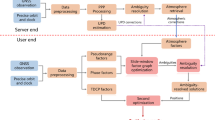Abstract
In this paper, a mathematical model for target tracking using nonlinear scalar range sensors is formulated first. A time-shift sensor scheduling strategy is addressed on the basis of a k-barrier coverage protocol and all the sensors are divided into two classes of clusters, active cluster, and submissive cluster, for energy-saving. Then two types of time-shift nonlinear filters are proposed for both active and submissive clusters to estimate the trajectory of the moving target with disturbed dynamics. The stochastic stability of the two filters is analyzed. Finally, some numerical simulations are given to demonstrate the effectiveness of the new filters with a comparison of EKF.
Similar content being viewed by others
References
Akyildiz I F, Su W L, Sankarasubramaniam Y, and Cayirci E, A survey on sensor networks, IEEE Communications Magazine, 2002, 40(8): 102–114.
Brooks R, Ramanathan P, and Sayeed A M, Distributed target classification and tracking in sensor networks, Proc. of IEEE, 2003, 91(8): 1163–1171.
Kumar S, Zhao F, and Shepherd D, Collaborative signal and information processing in microsensor networks, IEEE Signal Processing Magazine, 2002, 19(2): 13–14.
Zhao F, Shin J, and Reich J, Information-driven dynamic sensor collaboration for tracking applications, IEEE Signal Processing Magzine, 2002, 19(2): 61–72.
Brooks R, Griffn C, and Friedlander D, Self-organized distributed sensor network entity tracking, Int. J. of High Performance Comput. Application, 2002, 16(3): 207–219.
Jazwinski A H, Stochastic Process and Filtering Theory, Dover Publications, 2007.
Julier S, Uhlmann J, and Durrant-Whyte H, A new approach for filtering nonlinear system, Proc. of the American Control Conference, Washington, DC, 1995, 1628–1632.
Doucet A, Freitas N D, and Gordon N J, Sequential Monte Carlo Methods in Practice, Springer, 2001.
Reif K, Gunther S, Yaz E, and Unbehauen R, Stochastic stability of the continuous-time extended Kalman filter, IEE Proc. Contr. Theory and Appl., 2000, 147(1): 45–52.
Hu J and Hu X, Optimal target trajectory estimation and filtering using networked sensors, Journal of Systems Science and Complexity, 2008, 21(3): 325–336.
Hu J and Hu X, Nonlinear filtering in target tracking using cooperative mobile sensors, Automatica, 2010, 46(12): 2041–2046.
He Y and Chong E, Sensor scheduling for target tracking in sensor networks, Proc. of the 43rd IEEE CDC, Atlantis, Bahamas, 2004, 743–748.
Atia G K, Veeravalli V, and Fuemmeler J A, Sensor scheduling for energy-efficient target tracking in sensor networks, IEEE Trans. on Signal Processing, 2011, 59(10): 4923–4937.
Kumar S, Lai T H, Posner M E, and Sinha P, Optimal sleep-wakeup algorithms for barriers of wireless wensors, Proc. of the 4th International Conference on Broadband Communications, Networks and Systems (BROADNETS), 2007, 327–336.
Ammari H M and Das S K, Centralized and custered k-coverage protocols for wireless sensor networks, IEEE Trans. on Computers, 2012, 61(1): 118–133.
Kumar S, Lai T H, and Arora A, Barrier coverage with wireless sensors, Proc. of the 11th Annual International Conference on Mobile Computing and Networking (ACM MobiCom), 2005, 284–298.
Zhang H and Hou J C, Is deterministic deployment worse than random deployment for wireless sensor networks?, Proc. of the 25th IEEE International Conference on Computer Communications (INFOCOM), Spain, 2006, 1–13.
Xing G, Wang X, Zhang Y, Lu C, Pless R, and Gill C, Integrated coverage and connectivity configuration for energy conservation in sensor networks, ACM Trans. Sensor Networks, 2005, 1(1): 36–72.
Zakai M, On the ultimate boundedness of moments associated with solutions of stochastic differential equations, SIAM J. Control, 1967, 5(4): 588–593.
Cheng D, Ghosh B, and Hu X, Distributed sensor network for target tracking, Proc. of MTNS 2006, Kyoto, 2006, 2171–2183.
Olfati-Saber R and Murray R, Consensus problems in networks of agents with switching topology and time-delays, IEEE Trans. Automatic Control, 2004, 49(9): 1520–1533.
Author information
Authors and Affiliations
Corresponding author
Additional information
This work is supported by the National Natural Science Foundation of China under Grant No. 61104104, the Scientific Research Foundation for the Returned Overseas Chinese Scholars, State Education Ministry of China and the Program for New Century Excellent Talents in University under Grant No. NCET-13-0091.
This paper was recommended for publication by Editor ZHANG Jifeng.
Rights and permissions
About this article
Cite this article
Hu, J., Hu, X. & Shen, T. Cooperative shift estimation of target trajectory using clustered sensors. J Syst Sci Complex 27, 413–429 (2014). https://doi.org/10.1007/s11424-014-2191-0
Received:
Revised:
Published:
Issue Date:
DOI: https://doi.org/10.1007/s11424-014-2191-0




